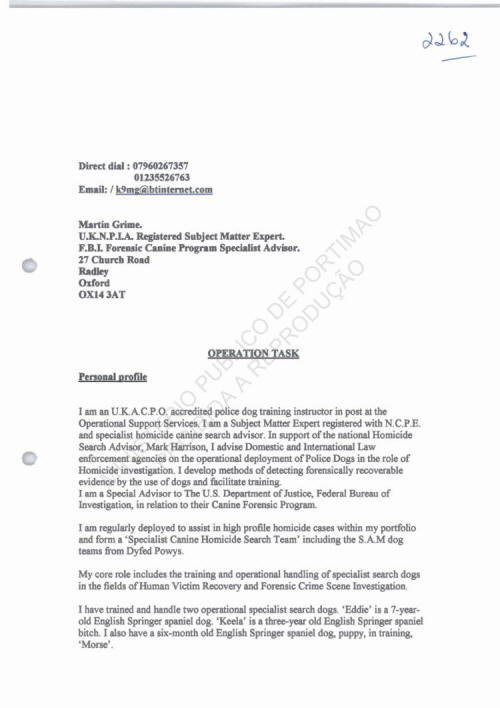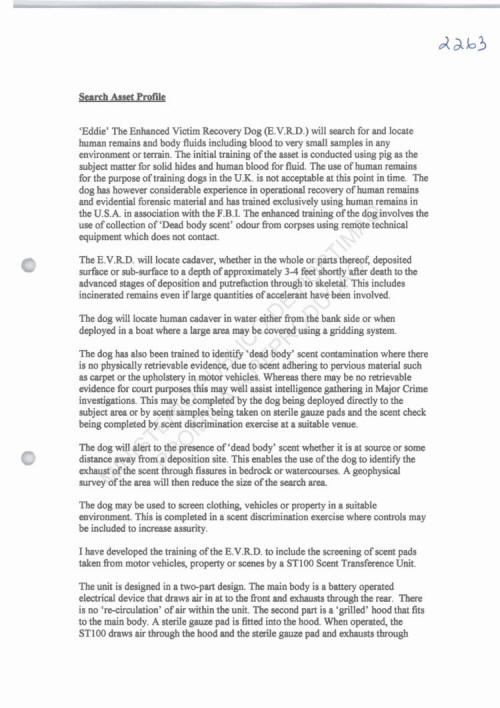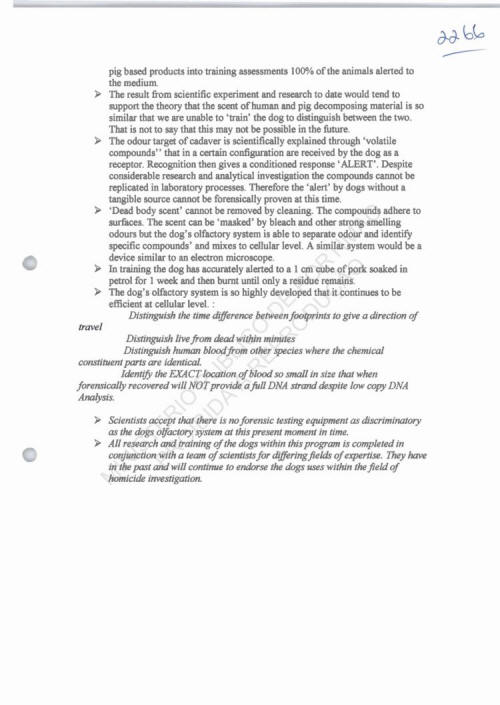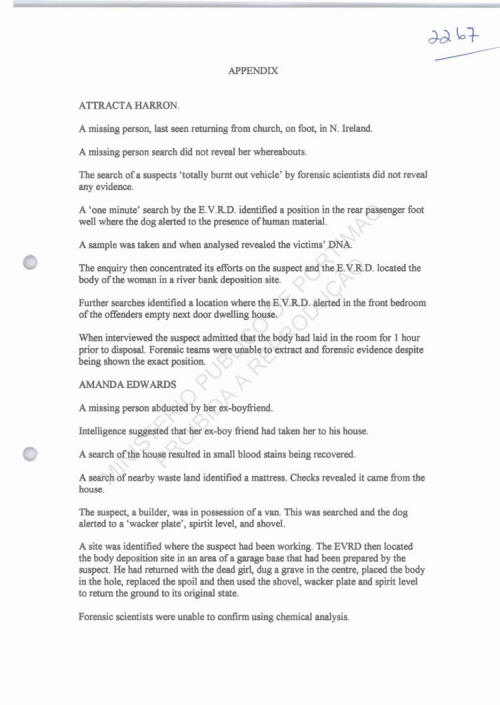2262 to 2268
Martin
Grime personal profile (
English)
2813 to 2835 Martin
Grime Personal Profile |
09-Processo 9..Pages 2262 to 2268
11 also
Processo XI 2813 to 2835 |
|
VOLUME_IXprocesso_2262 |
 |
|
VOLUME_IXprocesso_2263 |
 |
|
VOLUME_IXprocesso_2264 |
 |
|
VOLUME_IXprocesso_2265 |
 |
|
VOLUME_IXprocesso_2266 |
|
 |
|
VOLUME_IXprocesso_2267 |
|
 |
|
VOLUME_IXprocesso_2268 |
|
 |
Personal
Profile
I
am an
U.K.A.C.P.O.
accredited
police
dog
training
instructor
in
post
at
the
Operational Support Services. I
am a Subject Matter
Expert registered with N.C.P.E.
and specialist homicide canine search advisor.
In support of
the national Homicide
Search Advisor, Mark Harrison, I
advise Domestic and International Law
enforcement agencies on the
operational deployment of Police
Dogs in
the role of
Homicide investigation. I
develop methods of detecting forensically recoverable
evidence by the use of
dogs and facilitate training.
I am a Special Advisor to
The U.S. Department of
Justice, Federal Bureau of
Investigation, in
relation to their Canine Forensic Program.
I
am regularly deployed to assist
in high profile homicide
cases within my portfolio
and form a 'Specialist Canine Homicide Search Team'
including the S.A.M
dog
teams from Dyfed Powys.
My core role includes the
training and operational
handling of specialist search dogs
in
the fields of Human
Victim Recovery and Forensic Crime Scene Investigation.
I have trained and handle
two operational specialist search dogs. 'Eddie' is a
7-yearold
English Springer spaniel dog.
'Keela' is a three-year old English Springer spaniel
bitch. I also have a
six-month old English Springer spaniel
dog, puppy,
in
training,
'Morse' .
Search
Asset Profile
'Eddie' The Enhanced
Victim Recovery Dog (E.V.RD.)
will search for and locate
human remains and body fluids including blood to very
small samples in any
environment or terrain. The
initial training of
the asset is conducted
using pig as the
subject matter for solid hides and human blood for
fluid. The use of human
remains
for the purpose of
training dogs
in
the U.K. is not
acceptable at this point
in time.
The
dog has however
considerable experience in
operational recovery of human remains
and evidential forensic material and has trained
exclusively using human remains
in
the U.S.A.
in association with
the F.B.I.
The enhanced
training of
the
dog involves
the
use of collection of 'Dead body scent' odour from
corpses using remote technical
equipment which does not contact.
The E.V.R.D. will locate
cadaver, whether in
the whole or parts
thereof; deposited
surface or sub-surface to a depth of approximately 3-4
feet shortly after death to the
advanced stages of deposition and putrefaction through
to skeletal. This includes
incinerated remains even if large quantities of
accelerant have been involved.
The
dog will locate human
cadaver in water either
from the bank side or
when
deployed in a boat where
a large area may be covered using a gridding system.
The
dog has also been trained
to identify 'dead body' scent contamination where there
is no physically retrievable evidence, due to scent
adhering to pervious material such
as carpet or the
upholstery in motor
vehicles. Whereas there may be no retrievable
evidence for court purposes this may well assist
intelligence gathering in
Major Crime
investigations. This may be completed by
the
dog being deployed
directly to the
subject area or by scent samples being taken on sterile
gauze pads and the scent
check
being completed by scent discrimination exercise
at a suitable venue.
The
dog will alert to
the presence of 'dead
body' scent whether it is at
source or some distance away from a deposition site.
This enables the use of
the
dog to identify
the exhaust of
the scent through
fissures in bedrock or
watercourses.
A geophysical survey
of the area will then
reduce the size of
the search area.
The
dog may be used to screen
clothing, vehicles or property
in a suitable
environment. This is completed
in a scent discrimination exercise where controls
may be included to increase assurty.
I have developed
the
training of
the E.V.R.D. to include
the screening of scent
pads
taken from motor vehicles, property or scenes by a ST100
Scent Transference Unit.
The unit is designed
in a two-part design.
The main body is a
battery operated
elect.rica1 device that draws air
in
at to
the front and exhausts
through the rear. There
is no 're-circulation' of air within
the unit.
The second part is a
'grilled' hood that fits to the
main body. A sterile gauze pad is fitted into
the hood. When operated,
the ST100 draws air
through the hood and
the sterile gauze pad and
exhausts through
ports to
the rear. 'Scent' is
trapped in
the gauze, which may then
be forensically
stored for use within scent discrimination exercises.
The ST 100 unit is
cleaned following use in
such a manner that no residual scent is
apparent. This is checked by control measures where
the
dog is allowed to search
a
given area where the S
100 is secreted. Any response by
the dog would
suggest
contamination. Tests have shown that
the decontamination
procedures are effective in
this case with the
dog NOT alerting to
the device when
completed.
Use of the ST 100 is
recommended when subject vehicles, property, clothing,
premises
are to be forensically protected from contamination by
the
dog, and for covert
deployment. At a11 other
times best practice would be for
the dog to be
given direct access.
Operational use of the
STü100 is in a
developmental stage.
'Keela' The Crime Scene
Investigation (C.S.I.)
dog will search for and
locate human
blood to such small proportions that it is unlikely to
be recovered by the
forensic
science procedures in
place at this time due to
its size or placement.
She will locate contaminated weapons, screen motor
vehicles and items of clothing
and examine crime scenes for minute human blood
deposits. She will accurately
locate human blood on items that have been subjected to
'clean up operations' or
having been subjected to severa1 washing machine cycles.
In
training she has
accurately located minute samples of blood on property
up to
thirty-six years old.
In order for
the
dog to locate
the source
the blood must have
'dried' in situ. Any
'wetting' once dried will not affect
the
dog's abilities.
Blood that is subjected to dilution by precipitation or
other substantial water source
prior to drying will soak into
the ground or other absorbent material. This may
dilute
the scent to
an unacceptable leve1 for
accurate location.
It is possible however that the
EVRD will locate the
scent source as it would for 'dead body' scent. Forensic
testing may not produce evidence but any alert may
provide
intelligence to support other factors
in
the investigation of a
crime.
The assets may be
deployed upon request of an
Senior Investigating Officer (S.I.O.)
following consultation with the
appropriate S.M.E.'s and advisors.
The project team makes
decisions on suitability for case deployment. Due to
the very
nature of the
dog's presence, cross
contamination and preservation of vital evidence
at
crime scenes must be considered prior to any deployment
in consultation with
the
senior crime scene coordinator.
|
|
Both dogs
and I are licensed as two
separate working teams. We are independently
tested and licensed annually, normally
at six monthly intervals
as a 'rolling'
programme to ensure best practice is maintained. They
are tested to units of
assessment prepared as a stand-alone system as these
dogs are the only assets
of their
type in
the world.
Training records are
maintained and are available if required.
POINTS TO ASSIST
Whilst it is stated that the
E.V.R D. is originally trained using pig
the following notes
of guidance should be considered when assessing
indications:
P In six years
operational deployment in
over 200 cases the
dog has never
alerted to meat based foodstuffs.
> The
dog has never alerted to
'road kill'
P Alerts given by the
dog where no obvious
human remains are found are
supported by forensic evidence I
anecdotal witness accounts.
> The
dog, a scavenger, uses
its olfactory system to locate food sources, identify
its young and other pack members, enemies and predators
over large
distances. It can track its prey identifying a direction
of travel. This entails the
dog being able to
discriminate the time
difference between footsteps using
the
sense of smell !
> The
dog is
an animal that's basic
function in
the wild is to scavenge
food and
procreate.
> In a domestic
environment it responds to humans as a food source and
bonds
in
the manner it would with
other pack members.
> The reward of food and
protection / close comfort provides
the basis for a
system to be adopted where the
dog shows a willingness
to respond in
response to the reward.
We are thereby able to 'train'
the dog using
conditioned responses to stimuli. Repetition and reward
then ensure
efficiency. Positive and negative reinforcement then
shape the required
behaviour in their role.
P Pavlov's theory is used in
the case of
the E.V.RD. system of
alert. He has
been 'conditioned' to give a verbal alert when coming
into contact with 'dead
body scent'. The presence
of tangible material is not required to produce
the
response.
> Although the
dog is 'trained' using
reward based methods the
behaviour
shaping and enforcement regime produces
an asset that does not
false alert
unlike electronic devices.
> Pseudo scent is a chemically produced product that its
manufacturers claim to
resemble 'dead body scent'. Although some trainers have
had limited success
when tested on my dogs they showed no interest.
> Operational finds backed by forensic corroboration
have shown that the
system adopted by me in
the
training of
the dogs is both
effective and
efficient. Acting in my
role of advisor to the
U.S. Justice Department I
have
facilitated
assessment of numerous cadaver search
dog teams
in
the United
States. These dogs
are exclusively trained using human cadaver sources.
When I introduced |
pig based
products into training assessments 100%! of
the animals alerted to
the medium.
> The result from
scientific experiment and research to date would tend to
support the theory that
the scent of human and
pig decomposing material is so
similar that we are unable to 'train'
the
dog to distinguish
between the two.
That is not to say that this may not be possible
in
the future.
> The odour target of
cadaver is scientifically explained through 'volatile
compounds" that in a
certain configuration are received by
the
dog as a
receptor. Recognition then gives a conditioned response
'ALERT'. Despite considerable research and analytical
investigation the
compounds cannot be replicated
in laboratory processes.
Therefore
the 'alert' by dogs without a tangible source
cannot be forensically proven at
this time.
> 'Dead body scent' cannot be removed by cleaning.
The compounds adhere to
surfaces. The scent can
be 'masked' by bleach and other strong smelling
odours but the
dog's olfactory system is
able to separate odour and identify
specific compounds' and mixes to cellular level. A
similar system would be a
device similar to an
electron microscope.
> In
training
the
dog has accurately
alerted to a 1 cm cube of pork soaked
in
petrol for 1 week and then burnt until only a residue
remains.
>The
dog's olfactory system is
so highly developed that it continues to be efficient
at cellular level:
Distinguish the time
difference between footprints to give a direction of
travel.
Distinguish live from dead within minutes.
Distinguish human blood from other species where
the chemical constituent
parts are identical.
Identify the EXACT
location of blood so small in
size that when forensically recovered will NOT provide
a full DNA strand despite low copy DNA analysis.
> Scientists accept that there is no forensic testing
equipment as discriminatory as
the dogs olfactory system
at this present moment in
time.
>All research and training
of the dogs within this
program is completed in
conjunction with a team of scientists for differing
fields of expertise.
They have
in
the past and will
continue to endorse the
dogs uses
within the field of
homicide investigations.
|
Page 2267
APPENDIX.... (To Martin Grime Profile Report)
ATTRACTA HARRON.
A missing person, last seen returning from church, on
foot, in N. Ireland.
A missing person search did not reveal her whereabouts.
The search of a suspect's 'totally burnt out vehicle' by
forensic scientists did not reveal any evidence.
A 'one minute' search by the EVRD identified a position
in the rear passenger footwell where the dog alerted to
the presence of human material.
A sample was taken and when analysed revealed the
victim's DNA.
The enquiry then concentrated it's efforts on the
suspect and the EVRD located the body of the woman in a
river bank deposition site.
Further searches identified a location where the EVRD
alerted in the front bedroom of the offender's empty
next door dwelling house.
When interviewed the suspect admitted that the body had
laid in the room for 1 hour prior to disposal. Forensic
teams were unable to extract any forensic evidence
despite being shown the exact position.
AMANDA EDWARDS
A missing person abducted by her ex-boyfriend.
Intelligence suggested that her ex-boyfriend had taken
her to his house.
A search of the house resulted in small blood stains
being recovered.
A search of nearby waste land identified a mattress.
Checks revealed it came from the house.
The suspect, a builder, was in possession of a van. This
was searched and the dog alerted to a 'wacker plate',
spirit level, and shovel.
A site was identified where the suspect had been
working. The EVRD then located
the body deposition site in an area of a garage base
that had been prepared by the suspect. He had returned
with the dead girl, dug a grave in the centre, placed
the body in the hole, replaced the spoil and then used
the shovel, wacker plate and spirit level to return the
ground to its original state.
Forensic scientists were unable to confirm using
chemical analysis.
|
|
Page 2268
CHARLOTTE PINKNEY
Charlotte Pinkney was abducted by an ex-boyfriend and
has never been seen since.
An initial search by the EVRD revealed a 'classic'
secondary deposition site near to a sighting of the
suspect in suspicious circumstances.
The investigative team distrusted the dogs opinion until
a full forensic search revealed a small button off of
the girls clothing in long grass.
This evidence was put to the suspect who fully admitted
the offence.
There are many instances such as this.
The most poignant being :
When 'Keela' was nine months old she was tasked to
search an open fishing boat, contaminated by rotting
fish flesh and BLOOD.
A missing person was believed to have killed on the
boat.
The dog located and alerted to a blood sample that was
so small that when LOW
COPY analysed was reported as being PRIMATE and an
uncompleted sample.
There are only two scenarios to suit this find. The
blood was either human or a gorilla went out in a boat
fishing ! !
Should you require further examples or comments, please
do not hesitate to contact me.
Mark Harrison |
|